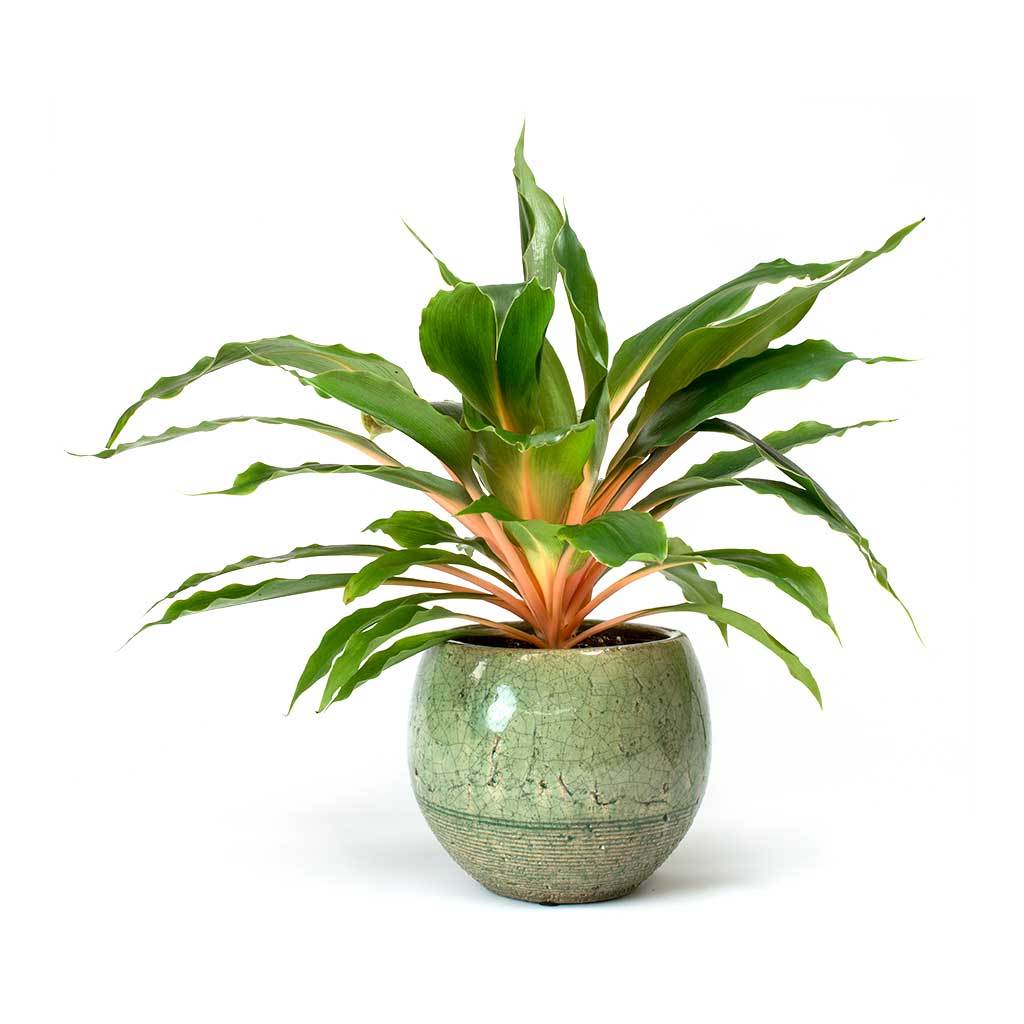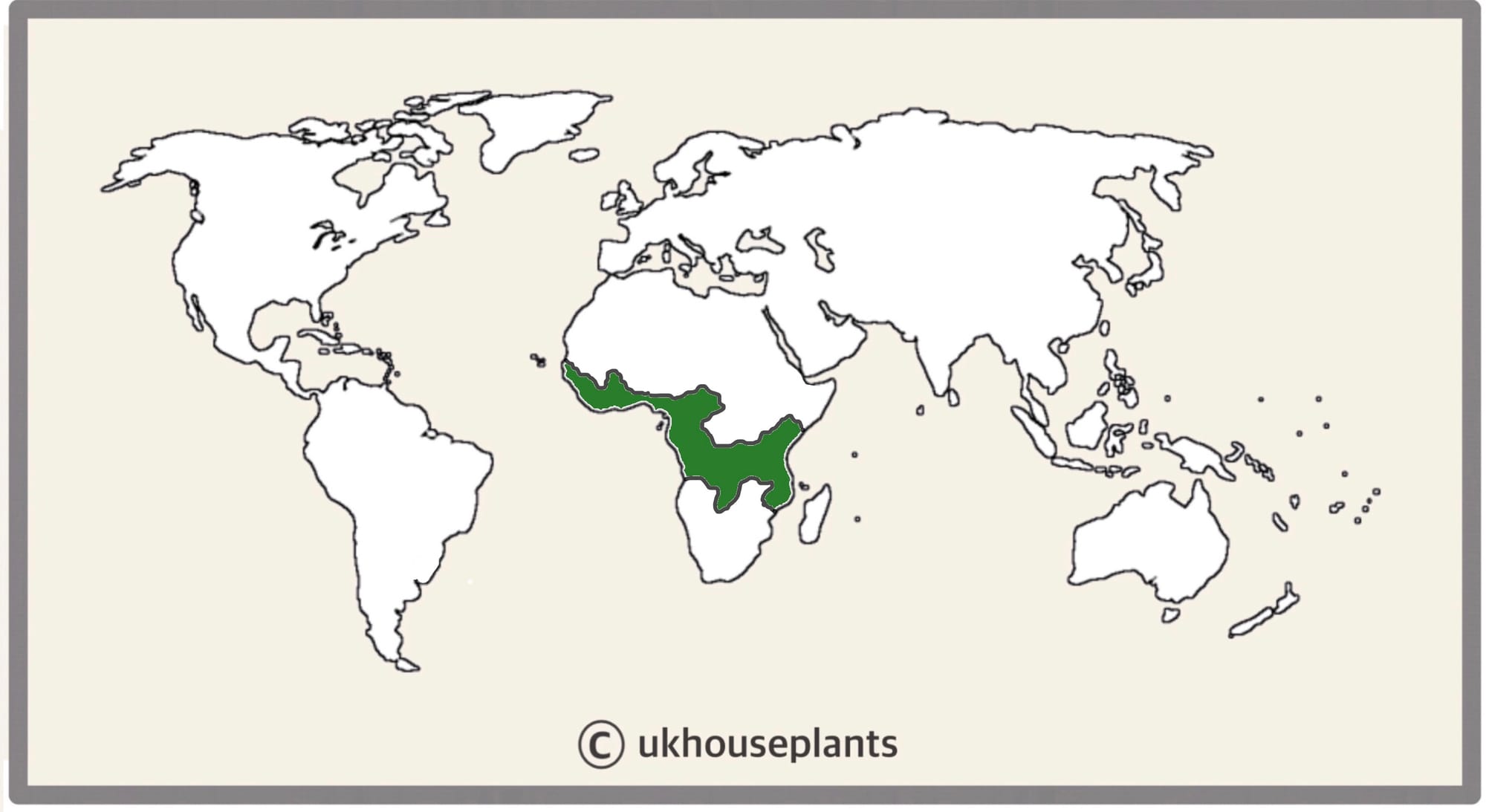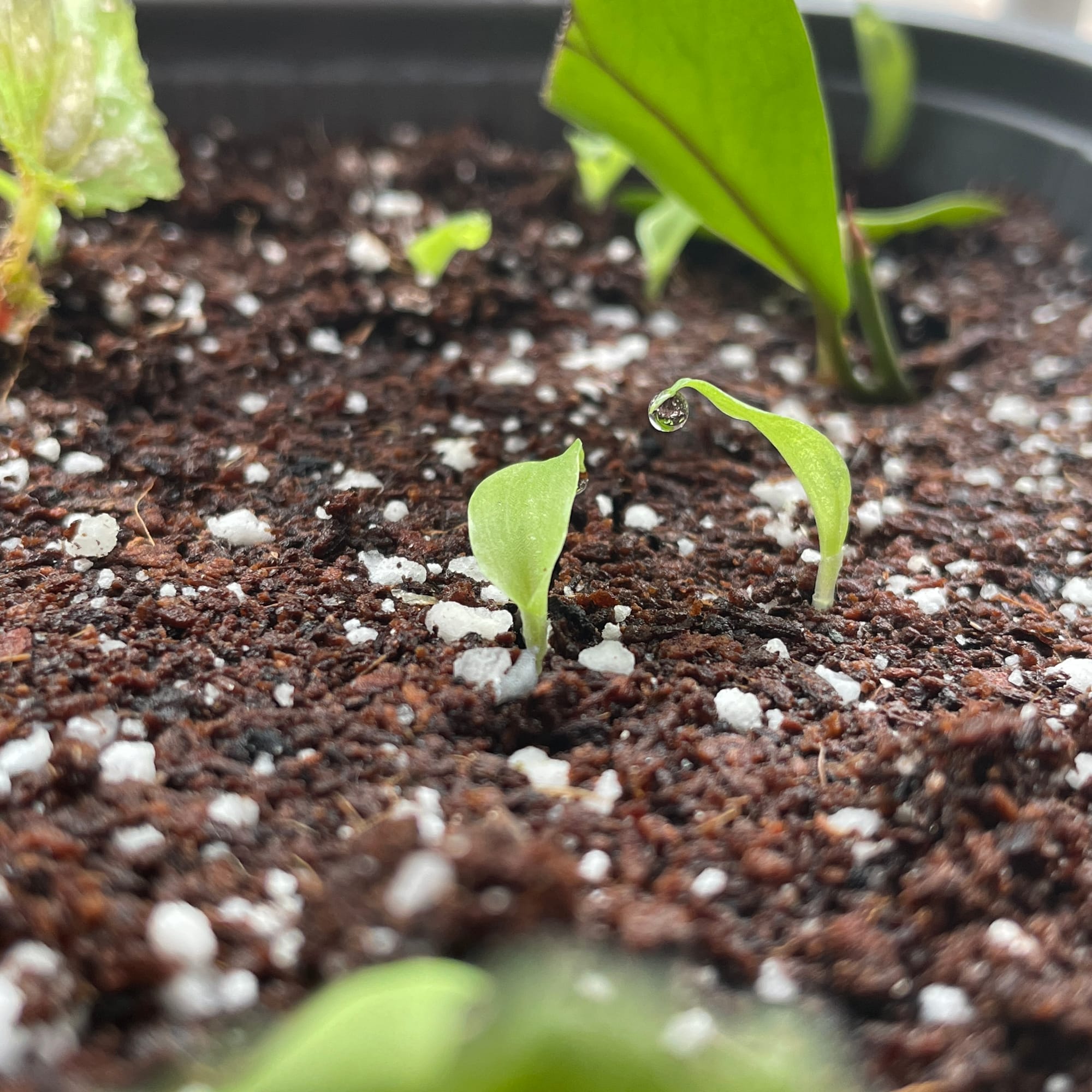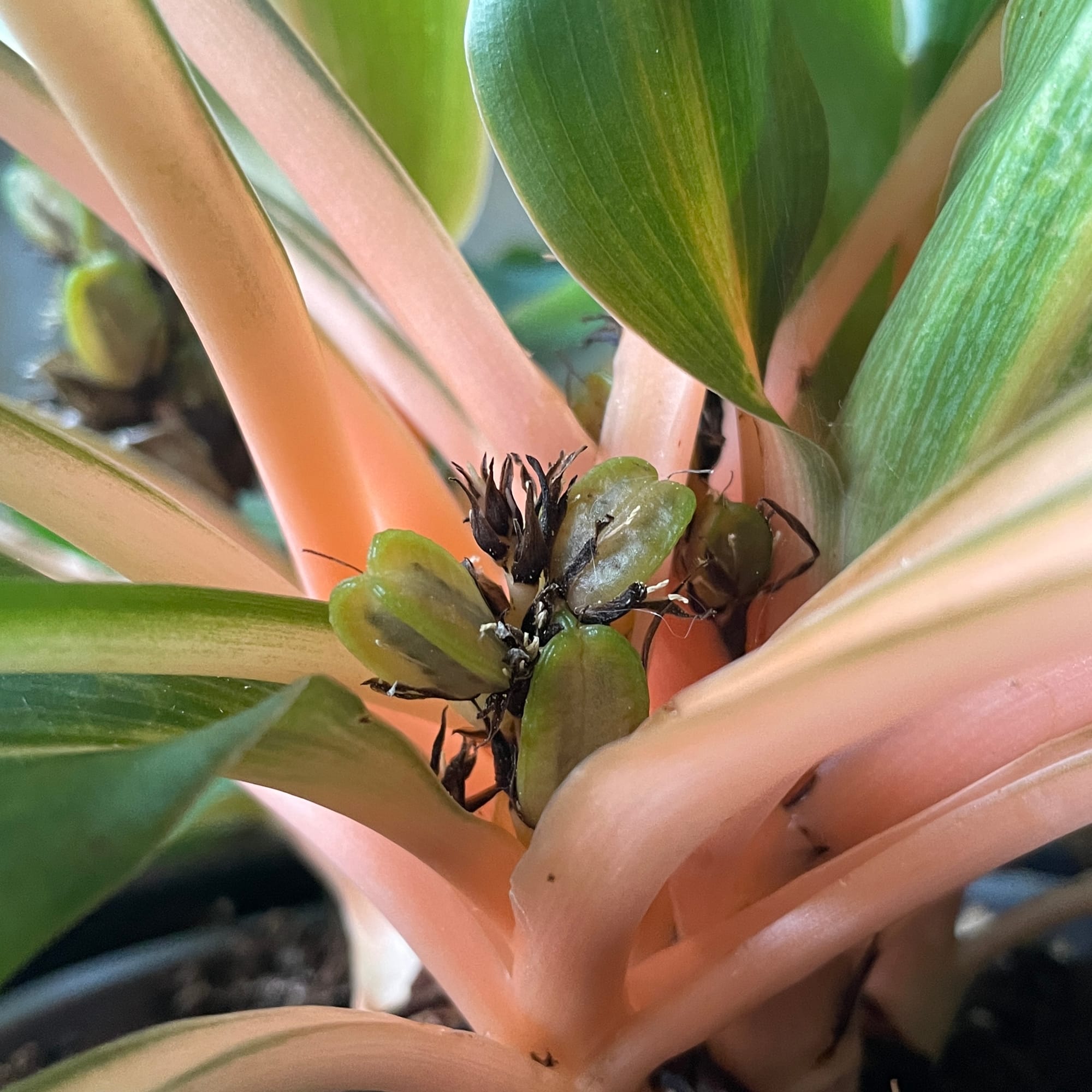
Chlorophytum orchidastrum - Copyright: Hortology
Contents
- Top Tips
- Location, Water, Humidity & Fertilisation
- Common Issues
- Origins, Temperature, Propagation, Repotting & Toxicity.
Are you struggling to find the answer to your specific plant issue? Book a 1-to-1 video call with THE HOUSEPLANT DOCTOR™, the website's friendly author, to overcome and address your niggling problem! Available on iMessage, WhatsApp, Facebook Messenger & more.
Top Tips & Info
- Care Difficulty - Easy to Moderate
- Provide a bright, indirect location with little to no direct sunlight - a north, east or west-facing windowsill is perfect for good, quality growth.
- Allow the top third of the soil to dry between waters, reducing this slightly further in the autumn and winter.
- Average room humidity is acceptable for this species.
- Fertilise using a 'Houseplant' labelled feed every four waters.
- Repot every two years during the spring, using a 'Houseplant' labelled potting mix.
- Keep an eye out for Spider Mites & Mealybugs that'll hide in the plant's cubbyholes; however, pests are usually uncommon with Chlorophytum orchidastrum.
Location & Light - 🔸🔸
A bright, indirect site is best for this specimen, as shady environments may lead to soil mould and slowed growth. Although the risk of sun-scorch is high with sun-filled locations, a location that offers up to two hours of morning or evening sunlight is acceptable, as long as the specimen is kept moist. Never situate this plant in all-day sunlight due to the risk of foliage decline and plant death.
Water - 🔸🔸🔸
Allow the compost's top third to dry out in between waters in the growing period, reducing this slightly further in the autumn and winter. Under-watering symptoms include a sudden loss of older foliage, yellowed or crispy foliage & stunted growth, whereas over-watering symptoms including a weakened or rotten stem, no new growth, yellowing lower leaves and eventual plant death. Click here to learn more about root rot and how to address it!
Humidity - 🔸
Chlorophytum orchidastrum are prized for their tolerance of dry air, which means that average room humidity is more than enough to satisfy them. Never situate one within a few metres of an operating radiator due to the enriched chance of browning leaf-tips. If you have issues of under-watering, we'd recommend introducing a pebble tray to keep the surrounding environment moist, which indirectly will slow the rates of drying soil, too!
Fertilisation - 🔸🔸
Feed with a 'Houseplant' labelled fertiliser every four waters for the development of better quality foliage. Although a 'General Plant' fertiliser is acceptable, you'll run the risk of burning the roots if over-applied, especially with the combination of a 'ready-to-use' (RTU) product and dry soil. We'd recommend BabyBio or Miracle-Gro as good products to use!
Common Issues with Chlorophytum Orchidastrum
An array of simultaneous cultivation issues will increase the chance of developing yellowed leaf-sections with browned halos - see image below for visual reference. Firstly, the location may be too dark, with its compost staying too saturated in-between waters; if mould is growing across the soil, this is usually a bad sign. Further, you're potentially using too cold water or tap water that hasn't been allowed to sit for 24hrs. This period of rest will not only bunk-up its temperature, but the harsh chemicals used to preserve water hygiene (fluoride & chloride) will begin to alleviate after a few hours. If possible, use fresh bottled water from a shop or supermarket to prevent further chemical burns. The final culprit might be lack of fertilisation, with regular feeds being paramount for long-lasting, healthy leaves. If the specimen hasn't been nourished in over two months, it'll begin to show signs of nutrient deficiencies seen in this article.
If this common problem has occurred with your specimen, remove the affected leaves (not sections on the leaf) and improve the growing conditions considerably. Fertilise regularly with lukewarm water and be sure to allow the top third to dry out in between hydrations. Its new growth should be problem-free, but if you'd like to speak to ukhouseplants for more advice, don't be afraid to book a call with THE HOUSEPLANT DOCTOR™ via this link.
If your specimen is located in a dark environment with mould developing on the compost's top layer, use a chopstick to stab the soil in various areas gently. You should aim to enter the compost between the base of the plant and the pot's edge, as failure to do so may lead to damaging its lower portion. Leave the holes open for a few days before re-surfacing the soil to avoid it becoming overly dry. Not only will the gentle shift in the soil's structure mimic the work of small invertebrates in the wild (worms, etc.), but it'll also add oxygen back into the soil, thus reducing the risk of root rot. Repeat this monthly, or whenever you feel the potting-mix isn't drying out quickly enough.
Transplant shock is a big issue when it comes to heavy-handed repots. Give the plant a good soak 24hrs before the action and never tinker with the roots, unless it has been affected by root rot. Typical signs of transplant shock are largely similar to under watering, with wilting, yellowing leaves and stunted growth among the most common symptoms. Click here to learn more about addressing transplant shock and a step-by-step guide on performing the perfect transplant.
Origins
Chlorophytum orchidastrum has natural distributions across central Africa, ranging from The Gambia in the west to Zambia in the south. It was first described by John Lindley in 1824, using the Latin specific epithet of 'orchidastrum' in reference to the star-like flowers that'll produce ball-shaped seedpods two months after pollination.
 The Distribution of Chlorophytum orchidastrum.
The Distribution of Chlorophytum orchidastrum.
Temperature
12° - 32℃ (54° - 90℉)
H1b (Hardiness Zone 12) - Can be grown outdoors during the spring and summer in a sheltered location whilst nighttime temperatures are above 12℃ (54℉), but is fine to remain indoors, too. If you decide to bring this plant outdoors, don't allow it to endure more than an hour of direct sunlight a day as it may result in sun-scorch. Regularly keep an eye out for pests, especially when re-introducing it back indoors.
Spread
The overall size can be up to 0.5m (1.7ft) in height and width. The ultimate size will take between 5 - 10 years to achieve when repotted biannually, with several new leaves developing per season.
Pruning & Maintenance
Remove yellow or dying leaves, and plant debris to encourage better-growing conditions. While pruning, always use clean scissors or shears to reduce the chance of bacterial and fungal diseases. Remember to make clean incisions as too-damaged wounds may shock the plant, causing weakened growth and a decline in health.
Propagation
Via Seed or Basal Offset Division.
Seeds (Very Easy, See image below) - Your Orange Spider Plant will produce green triangular seedpods that'll hold around fifteen seeds. Once the seed pods become brown and begin to open, collect the seeds and soak in lukewarm water for around 24hrs in a dark, warm location. The best soil to use is a ‘Houseplant’ labelled potting mix; have a look at our own potting mixes on our shop. While using a seed tray, set the seeds ON TOP of the potting mix and place in a transparent bag (with holes) or in a transparent box with a lid. Maintain evenly moist soil and allow the excess water to freely drain from the pot's base to prevent water-logged conditions. The ideal location for successful germination is in a bright, indirect setting with temperatures above 18℃ (64℉) with bottom-heat. Keep the pot in a transparent bag to provide a stable level of humidity, along with longer-lasting soil moisture. Germination may take up to six weeks, so don't discard any unsuccessful seeds until this threshold has been surpassed. Remove the bag once the seedlings produce their third small leaf and split them into fours to repot into a 7cm pot with a similar soil.
Basal Offset Division (Easy) - Separating the basal offsets into their own pot will not only expand your plant collection, but it'll also slow the process of becoming pot bound. The best time to divide is during the spring period while repotting, with the pup's height surpassing a quarter of the mother's size. Gently brush away some of the soil to gain better access to the pup's base (lower stem) where the roots will be housed. While using a clean pair of secateurs or scissors, cut the stem with at least two root strands attached to its base. Set the pup in an appropriate-sized pot with adequate drainage and a 'Houseplant' labelled compost. The ideal location would provide bright, indirect light and temperatures above 15℃ (59℉). Maintain evenly moist soil, allowing the top third to dry out in between hydrations. After a month or two, treat it like a matured specimen by using the care tips mentioned above!
 Two week old seedlings where their current height is around 2cm (1 inch).
Two week old seedlings where their current height is around 2cm (1 inch).
Flowers
This species of Spider Flowers will flower from late spring onwards, producing many small white flowers along a 20cm shaft. Each individual inflorescence will last several weeks once opened, with the overall show lasting two months.
 The specific epithet, orchidastrum, refers to the star-like flowers that'll produce ball-shaped seed pods upon pollination.
The specific epithet, orchidastrum, refers to the star-like flowers that'll produce ball-shaped seed pods upon pollination.
Repotting
Repot every two years in the spring, using a 'Houseplant' labelled potting mix and the next sized pot with adequate drainage. Chlorophytum orchidastrum are far better potbound for several years due to the heightened risk of root rot and repotting-issues (like transplant shock) - so only repot if you feel it's wholly necessary.
Hydrate the plant 24hrs before tinkering with the roots to prevent the risk of transplant shock. For those situated in a darker location, introduce extra amounts of perlite and grit into the lower portion of the new soil to downplay over-watering risks. Click here for a detailed step-by-step guide on transplantation, or via this link to learn about repotting with root rot.
Pests & Diseases
Keep an eye out for mealybugs, aphids, spider mites, scale, thrips & whitefly. Common diseases associated with this species are root rot, red leaf-spot, heart rot, botrytis & southern blight - click here to learn more about these issues.
Toxicity
This plant is classified as non-poisonous, but if large quantities of the plant are eaten, vomiting, nausea and a loss of appetite could occur.
Retail Locations
Online Stores.
Book a 1-to-1 Call with THE HOUSEPLANT DOCTOR™
If you need further advice with your houseplants, book an advice call with ukhouseplants' friendly and expert writer today! This can be done via a video or audio call on most apps, including Facebook, FaceTime & Skype. A ten-minute call costs £5.99 (US$7), or £15.99 for thirty minutes. You can ask multiple questions, including queries on plants, pests, terrariums, repotting advice and anything in between. Please consider supporting this service to keep ukhouseplants thriving!